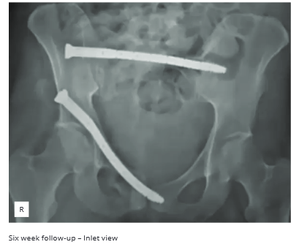

Pelvic Ring Injury in Polytrauma Treatment with the Curvafix IM System - Case Study
CASE PLANNING
The bilateral upper extremity fractures, the pre-existing contralateral lower limb amputation with loss of the prosthesis, and the patient`s need for immediate weight bearing on her right lower extremity were all considerations in proceeding with pelvic ring fixation using two CurvaFix IM Implants. Combined fixation of the anterior ring and the posterior ring provides the greatest stability and limits risk of late displacement, particularly of the parasymphyseal region. Of note, percutaneous screw fixation of the parasymphyseal region can be challenging in providing necessary stability.
CASE PRESENTATION
- A 40-year-old female had been struck by a vehicle and sustained multiple injuries:
- Right sacral fracture
- Right parasymphyseal injury
- Right sided superior pubic root injury
In addition, the patient had:
- Right proximal humerus fracture
- Left proximal humerus fracture
- Left intraarticular distal humerus fracture
- Flail chest
- Prior left below the knee amputation (prosthetic limb crushed in current trauma)
Upper extremity and chest wall
The flail chest was first repaired. Then, the upper extremities were stabilized (to facilitate weight bearing).
Posterier pelvic ring fixation
Using the implant technique, a curved tunnel was made from the right ilium across S1 to the left ilium. A CurvaFix IM Implant (130 mm in length) was placed in the tunnel across the posterior pelvic ring.
Anterior pelvic ring fixation
Using the implant technique, a curved anterior column tunnel was made down to and across the symphysis. A CurvaFix IM implant (140 mm in length) was then passed into the tunnel across the symphysis and locked in place.
FOLLOW-UP
At 6 weeks, the patient presented to clinic full weight bearing on the right lower extremity. Despite immediate weight bearing, there was no evidence of loss of reduction, hardware failure, or hardware loosening. There was evidence of bone healing.
KEY POINTS
- Posterior and anterior fixation with two CurvaFix IM Implants offered a patient with multiple injuries full weight bearing on the injured side while waiting for left lower limb prosthesis replacement.
- Fixation of the anterior fractures, so close to the symphysis, would have been difficult to hold with a straight screw. The curved implant was able to cross the symphysis for additional stability.
- The use of a curved implant in the narrow anterior column offers more flexibility on the starting point/trajectory than would be possible for a straight screw.

